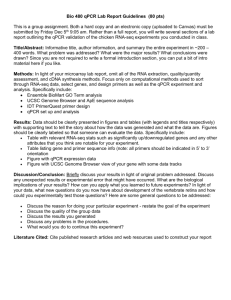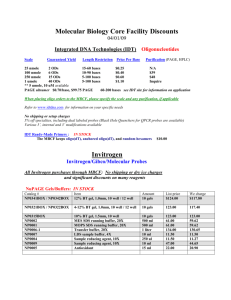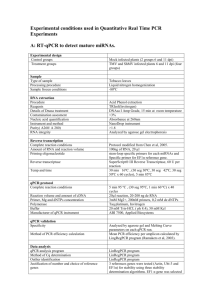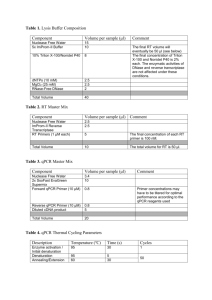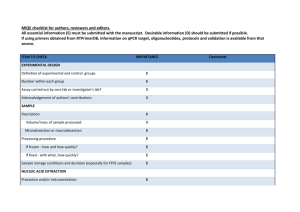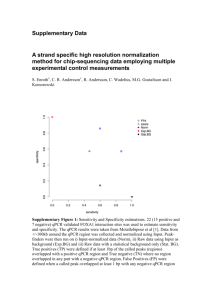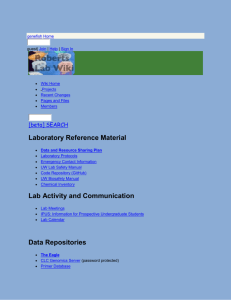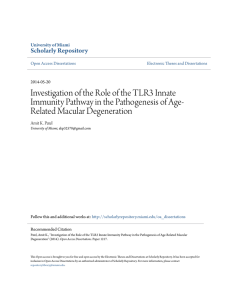Agarose gel electrophoresis RNA samples were denatured in
advertisement
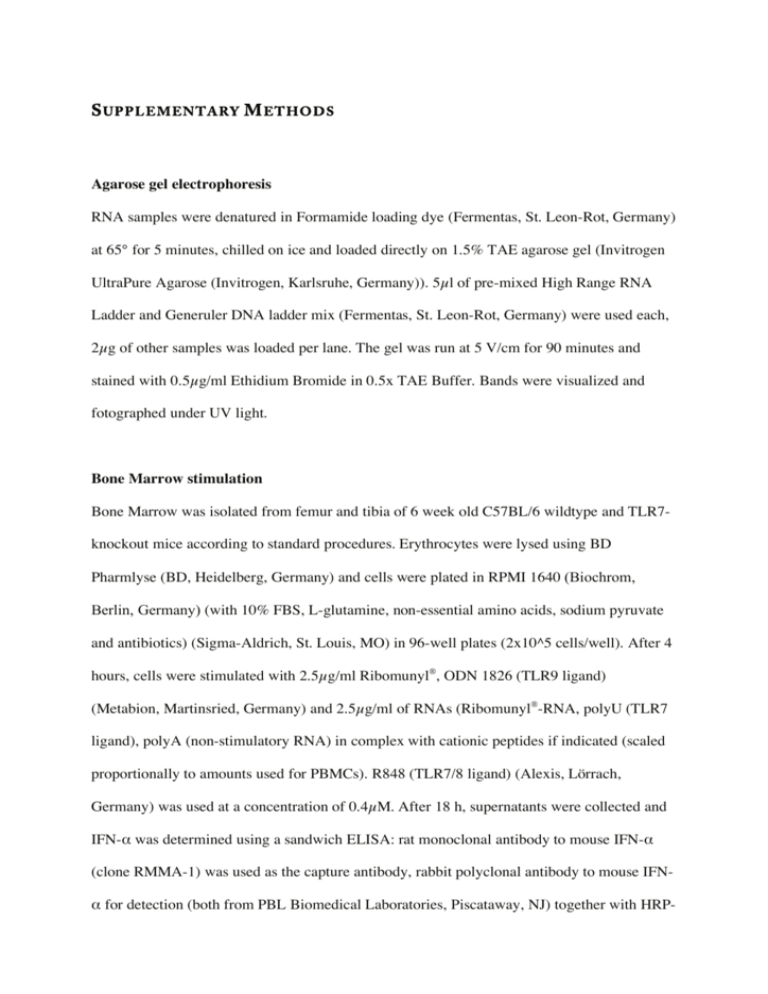
S UPPL E MEN T ARY M ET HO DS Agarose gel electrophoresis RNA samples were denatured in Formamide loading dye (Fermentas, St. Leon-Rot, Germany) at 65° for 5 minutes, chilled on ice and loaded directly on 1.5% TAE agarose gel (Invitrogen UltraPure Agarose (Invitrogen, Karlsruhe, Germany)). 5μl of pre-mixed High Range RNA Ladder and Generuler DNA ladder mix (Fermentas, St. Leon-Rot, Germany) were used each, 2μg of other samples was loaded per lane. The gel was run at 5 V/cm for 90 minutes and stained with 0.5μg/ml Ethidium Bromide in 0.5x TAE Buffer. Bands were visualized and fotographed under UV light. Bone Marrow stimulation Bone Marrow was isolated from femur and tibia of 6 week old C57BL/6 wildtype and TLR7knockout mice according to standard procedures. Erythrocytes were lysed using BD Pharmlyse (BD, Heidelberg, Germany) and cells were plated in RPMI 1640 (Biochrom, Berlin, Germany) (with 10% FBS, L-glutamine, non-essential amino acids, sodium pyruvate and antibiotics) (Sigma-Aldrich, St. Louis, MO) in 96-well plates (2x10^5 cells/well). After 4 hours, cells were stimulated with 2.5μg/ml Ribomunyl®, ODN 1826 (TLR9 ligand) (Metabion, Martinsried, Germany) and 2.5μg/ml of RNAs (Ribomunyl®-RNA, polyU (TLR7 ligand), polyA (non-stimulatory RNA) in complex with cationic peptides if indicated (scaled proportionally to amounts used for PBMCs). R848 (TLR7/8 ligand) (Alexis, Lörrach, Germany) was used at a concentration of 0.4μM. After 18 h, supernatants were collected and IFN- was determined using a sandwich ELISA: rat monoclonal antibody to mouse IFN- (clone RMMA-1) was used as the capture antibody, rabbit polyclonal antibody to mouse IFN for detection (both from PBL Biomedical Laboratories, Piscataway, NJ) together with HRP- conjugated donkey antibody to rabbit IgG as the secondary reagent (Jackson ImmunoLaboratories, West Grove, PA). Recombinant mouse IFN-A (PBL Biomedical Laboratories, Piscataway, NJ) was used as the standard. Lentiviral Vector production for TLR3 knock down: To introduce shRNA–expression cassettes into cells lentiviral vector particles were used. They were generated by using the 3rd generation packaging constructs pMD2.G, pRSV.Rev and pMDL.g/pRRE (Dull T. et al, 1998 J Virol 72(11):8463-8471). The shRNA-cassettes were encoded on pLKO.1 plasmids purchased from Sigma Aldrich (St. Louis, MO) (SHC 002 for non-targeting shRNA, TRCN0000056849 for shTLR3). For production of vector particles in HEK 293T cells 10 g shRNA-Plasmid, 2,5 g pRSV:Rev, 3,5 g pMD2.G and 6,5 g pMDL.g/pRRE were transfected into the cells via the calcium phosphate precipitation method (Hawley et al, 1989 Plasmid 22(2):120-131). Media was changes 12h post transfection. Vector containing supernatant was harvested 48h post transfection and cleared by filtration using a 0,45 m filter (Sartorius, Göttingen, Germany) and subsequently stored at -80°C. Generation of TLR3 knock down cell line For generation of knock down cells 50.000 IGROV cells were grown in 6 well plates and transduced with lentiviral particles. 48h post transduction cells were exposed to 5 g/ml puromycin. The selected cells were expanded and checked for knockdown via qPCR. qPCR Analysis of TLR3 expression: For qPCR Analysis whole RNA was extracted from IGROV cells using TRIzol (Invitrogen, Karlsruhe, Germany) according to manufacturers instructions. The following cDNA synthesis was performed using the SuperScript VILO cDNA Synthesis-Kit (Invitrogen, Karlsruhe, Germany). The qPCR on TLR3 was performed using the LC480 (Roche, Mannheim, Germany) on a probe based detection format. The qPCR was designed using the Roche Universal Probe Library Assay Design Center (probe # 88, Primer1: aaggctagcagtcatccaaca, Primer 2: agcaacttcatggctaacagtg). The assay was performed in a relative fashion compared to ß-Actin. Culture and stimulation of TLR3 reporter cells: IGROV cells with or without TLR3 knock down were cultured in RPMI Media containing 10% FCS. For stimulation, cells were seeded at 50.000 per 96 well and stimulus was added either directly to the supernatant or in complex with poly-L-Arginine (pArg) or Protamine as described in Method section. Ribomunyl® + Protamine aerosolic application A clean standard spray bottle used for intranasal application was filled with 4.75ml of sterile isotonic NaCl solution (0.9%). 250 μl of Ribomunyl® supension (1μg/μl) and 3.75μl of Protamin Valeant® 5000 (50μg/μl) were added, the bottle was shaken (5 seconds) and subsequently incubated for 20 minutes. The spray volume of one application was experimentally determined to be in average 50μl. Different parts of a 96-well plate containing PBMCs (4x10^5/well) in RPMI 1640 growth medium (100μl/well) were sprayed 0-10 times, as indicated.

